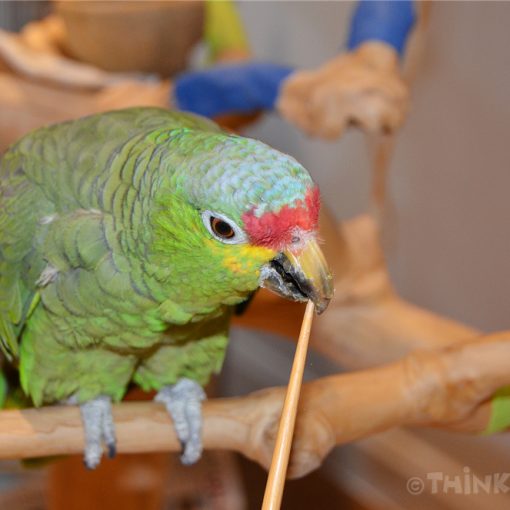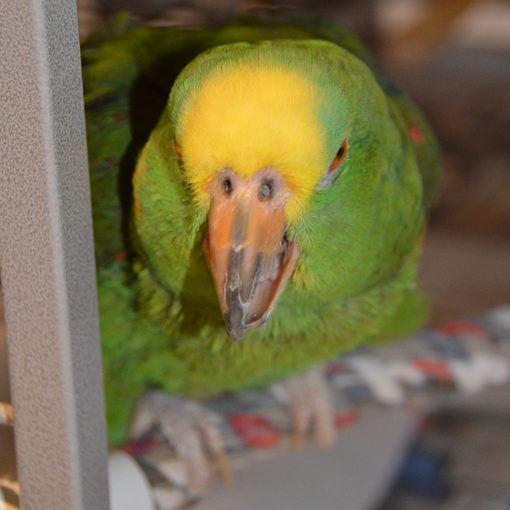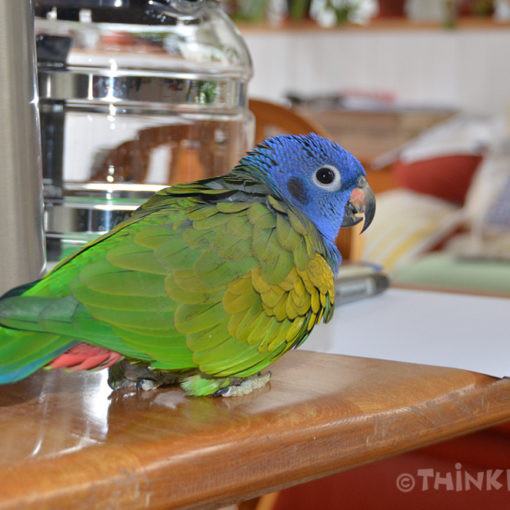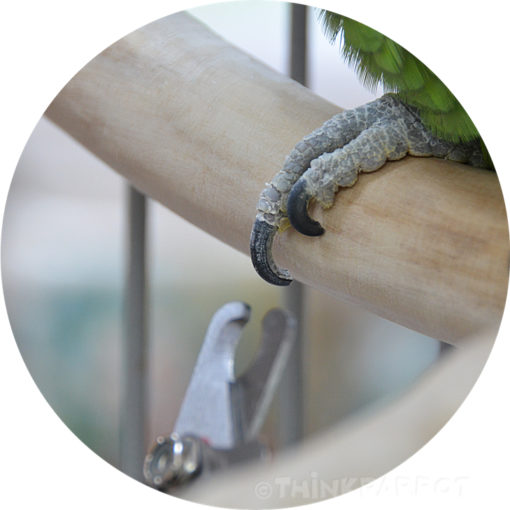If a consequence/outcome to a behaviour (the step up) is reinforcing, the parrot will most likely repeat the behaviour in the future.
For some birds, reinforcement for stepping up might be the chance to interact with their caregiver. Others may work better for a treat, a head scratch, access to a toy, being carried to a favoured place or simply for the reinforcement of being brought out of the cage.
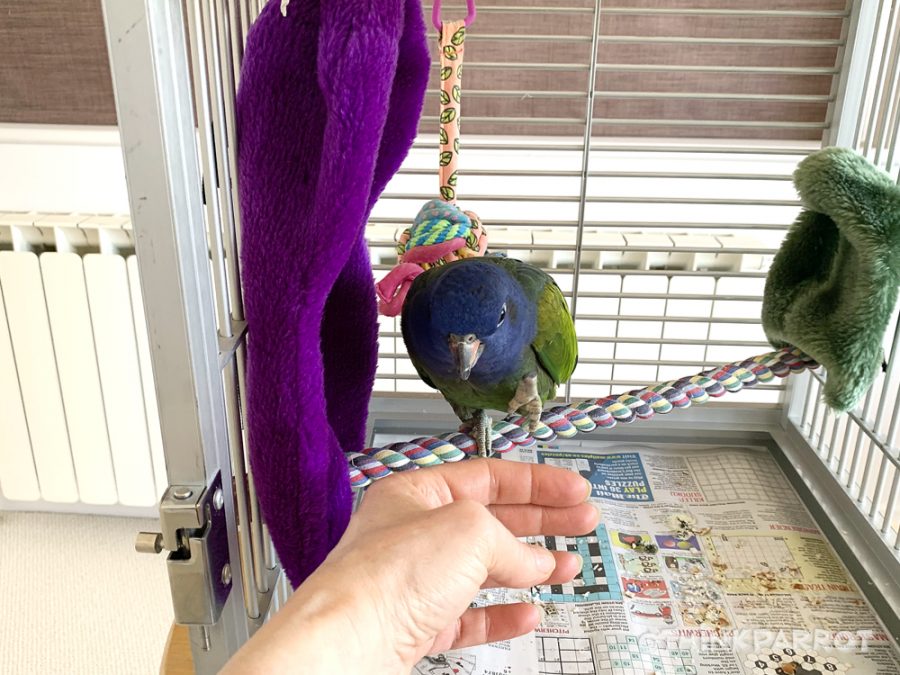
If the consequence is NOT reinforcing or if the step up has been regularly paired with aversives, a parrot is unlikely to want to step up in the future.
Aversives
It is commonplace to use force to bully our parrots into stepping up. We push our hand into the bird’s chest or perhaps we prise his feet off the perch. These are both examples of using negative reinforcement which is also known as escape/avoidance learning. The bird steps up to escape/avoid the pressure of the hand in the chest or the fingers pulling at his toes. Not only is the experience of stepping up paired with aversives (however mild in the eyes of the human) but the person using the negative reinforcement is also being paired with those aversives. A sure way to erode trust.
Fall out to negative reinforcement/aversives
Some birds quickly learn that lunging or biting will make the hand/aversive go away – they are then labelled as “aggressive” through no fault of their own. Some may become “fearful”, even to the point of phobia and try to get away from us/our hands. Others will continue to step up, but offer the absolute minimum behaviour in order to escape/avoid the aversives. Not a good place to be.
Positive reinforcement
By using positive reinforcement, we can make stepping up an enjoyable experience for the parrot. An experience our parrot will want to repeat in the future.
Body language
First and most importantly, notice the parrot’s body language – this is the main way our parrots communicate. Body language will tell us if our parrot is relaxed and willing to engage with us or is not comfortable with our approach. Only ask for a step up if the bird is relaxed and willing to engage – this will become increasingly likely if we use positive reinforcement.
Shape the step up
If the parrot consistently shows signs that he is not comfortable with our approach, then go back to basics and carefully shape the step up which is explained in this thread:
Step Up Training For Your Parrot Using Shaping.
Shaping the step up will provide many opportunities to earn positive reinforcement and therefore positive experiences for our fearful bird. An effective way to build/rebuild trust.
Aggressive responses also need to be treated sensitively when shaping the step up. As soon as the bird learns how to earn reinforcers his attitude will change. However, to begin with he is likely to continue to use body language that says, “I’m not comfortable – go away!” That’s fine – heed it way before it progresses to a lunge. Pushing forward until the bird has no option but to lunge or bite, is only teaching him to lunge or bite more at our approach. Calmly walk away at the first hint of uncomfortable body language – the opportunity for him to earn reinforcement has been temporarily lost. Try again when he is more relaxed.
If you are not feeling confident in shaping the step up, begin with the much easier Target Training so that the parrot learns about cause and effect and earning reinforcers. Then progress to shaping the step up since it is using exactly the same principles.
Targeting
If the bird knows how to target, ask him to step up by reaching for the target over your hand. The behaviour would be shaped by first getting him to touch a target progressively closer to your hand for lots of reinforcement. Then to touch it over your hand, until he has to put one foot on the hand, then two to reach the target. Be sure to keep the hand absolutely still and highly reinforce. Allow him to step off again immediately so he is in full control. Training duration (the length of time he’s on the hand before stepping off) and perching on a moving hand can be trained later. These are both discussed towards the end of this post:
Hand held perch
Teaching the parrot to step up onto a hand held perch is a useful behaviour as it can save hands being bitten in an emergency, or make it easier to reach a parrot in an inaccessible place.
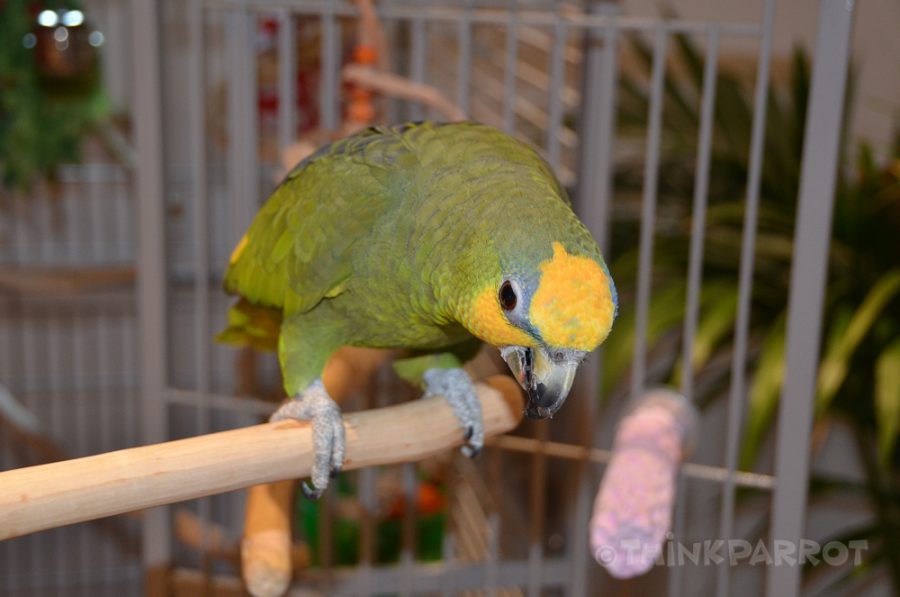
It can also be a way to move a parrot with a phobia about hands. Choosing something the parrot is already familiar with makes the process easier to teach. It doesn’t have to be a stick, it could be a folded rope perch, a basket handle, or even a cushion.
Step Up Training For Your Parrot Using Shaping.
Other general step up tips
- Our aim is to set our parrot up for success. To ask when we have his full attention, not when he’s in the middle of preening, killing a toy or eating. If he’s not ready, we can return in a minute or two.
- If the bird is not ready, and we stand with our perch or hand in front of the parrot, repeating, “Step up, step up, step up…” over and over, the verbal cue becomes meaningless – just noise – and we become annoying. The visual cue can start to get lost too. If the bird doesn’t step up within a certain time frame after being cued then walk away. Again, the opportunity for him to earn reinforcement has been lost. Try again a minute or two later when he’s more receptive.
- Sometimes a bird might need a prompt especially when initially learning the step up. Briefly showing them the treat, if that’s what you are using, might help to kick start the behaviour. However showing the treat before the behaviour (the step up) is a bribe or lure. It should be faded out as quickly as possible or else the parrot will just follow the treat and won’t properly learn the behaviour, or might decide that particular treat is not worth working for.
- Check hand placement. It is easier for a parrot to step up onto a hand that is a little higher than his feet, rather than step down to a hand below him.
- We may want to rethink the reinforcer: if the reinforcer is food, he may no longer be hungry, which is why breaking the treat into tiny prices will allow for more repetition.
- Try changing up the reinforcer for the step up so the parrot doesn’t know what he’s going to get next. Different treats, access to a toy, praise, being carried over to a window, etc. (whatever works for the bird).
- Another technique could be to use behavioural momentum which is asking for a few easy behaviours that he knows how to do first, and then without pausing ask for the more difficult behaviour – and of course highly reinforce it!
Make life easy for yourself and the parrot
Many caregivers have problems getting the bird to step up from inside his cage. Make life easy for yourself – why not just open the door and let the bird choose to come out when he wants to? That way the bird has choice and control – two important reinforcers. Maybe attach a short perch on the inside of the door so that when the door swings open, he has somewhere to climb to and sit. It also makes going back in easier too.
Emergency step up
Of course in a true emergency, the bird should be made safe and secure as quickly as possible by any means. An emergency in this household is someone unexpectedly at the front door. Kobe gets over excited at the sound of the doorbell and is likely to follow me to the door. He knows the emergency drill. I show Kobe his folded rope perch and he either immediately steps up on it or flies to it. He’ll stay on the perch as I carry him to his cage.
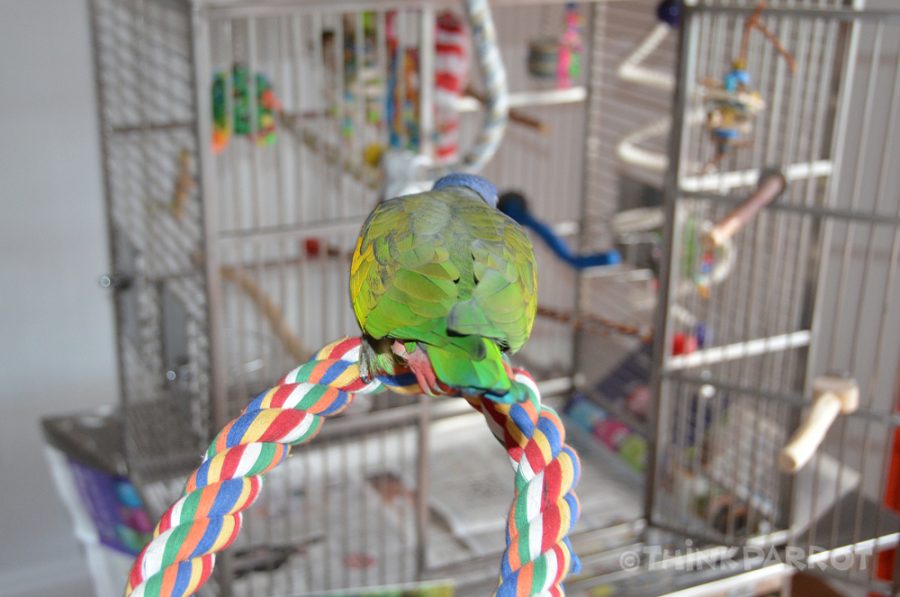
To get this fast 100% successful response, I taught Kobe to step up onto the folded rope perch from inside his night cage every morning. He is used to rope perches in his day cage so there was no need to desensitize him to it. Of course Kobe was eager to come out of the night cage so that was the reinforcer to step up. After months of stepping up onto the rope perch from inside his night cage without hesitation, the step up has become automatic. He also understands, through experience, that if I use this emergency procedure, I will always let him back out of his cage in a few minutes after the person has gone. This is the only time I use the folded rope perch.
But I have to rush to work!
If we ask a parrot to step up and he does, then we immediately put him into his cage and walk away, is that parrot likely to step up more, or less, in the future?
Of course it depends on the individual bird, but my guess for the majority, is less.
Therefore it’s important to teach our parrot that step up doesn’t necessarily mean going straight back into the cage. Even if we are rushing out, there is still lots of reinforcement we can provide en route. For example, we can ask for a step up and reinforce the behaviour with a treat, skritch, or opportunity to be with us. Then we could take him over to the window for a few minutes to ooooh and ahhh at what’s going on outside (certainly reinforcing for some individuals), then we carry him to his cage. But reinforcement doesn’t end there… look what’s waiting – breakfast, or a new toy, or foraging opportunity! Our parrot will most likely step up in the future even if we are rushing to go to work.
No step up? No problem!
With some thought and planning it is absolutely possible to move a parrot, who hasn’t yet been taught to step up, without touching him. After initially teaching Ollie, who had a phobia about hands, to step up onto a hand held perch I never actually used it to move him anywhere. The only exception was using the behaviour as part of crate training.
How to get a parrot to go back into his cage without touching him
Be sure the bird is used to eating his main meals inside his cage. Without changing the routine, let the parrot out an hour or so before breakfast. As soon as you slot in the breakfast bowl he should take himself back in to eat. Slowly shutting the cage door when he has a morsel of food in his mouth pairs the closing door with something good. This way he’ll likely repeat the behaviour next time. Try it with his evening meal too. Then gradually expand on the time the parrot is out of the cage.
This was a sure fire way to get Ollie into his cage without touching him. It became 100% reliable so fast, that after only a few days I could let him out before I went to work each morning knowing I’d have no trouble getting him back in. An extra reinforcer was that we then ate breakfast all together, birds inside their cages of course, before I left – parrots are social creatures and therefore like to eat as a flock.
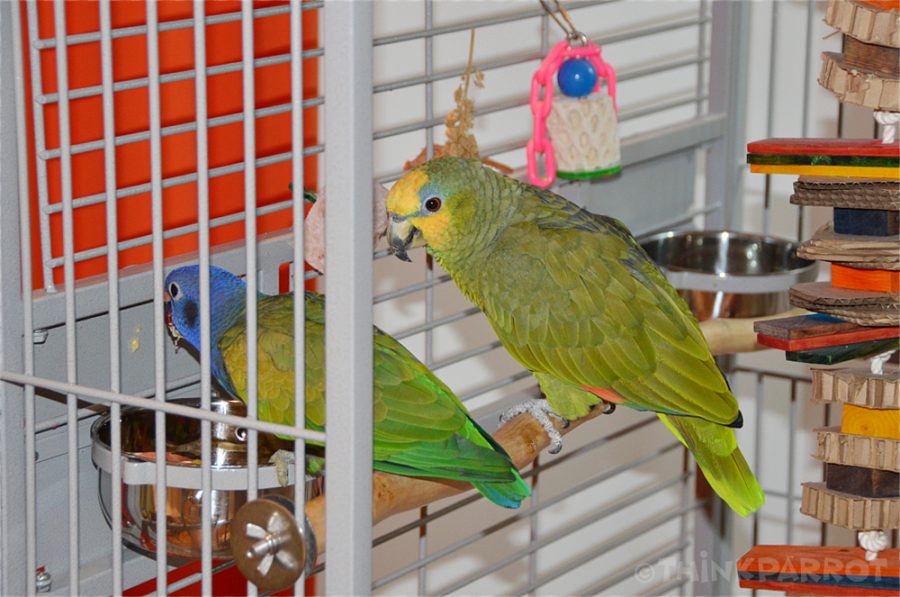
Targeting into the cage
Another method is to have the bird target back into the cage (or to other places). Just before bedtime, I do all sorts of training, including Target Training, with the birds on a perch on their cage doors or even inside the cage. The reinforcers are favourite treats. At the end of the session I might have the bird move to touch the target inside the cage and slowly shut the door whilst he’s eating the treat. Often they’ll just go in knowing more reinforcement is on the way in the shape of another treat or a head scratch. Again, no need for the bird to formally step up.
Resources:
Barbara Heidenreich’s:
https://goodbirdinc.blogspot.com/2013/01/help-my-parrot-wont-step-up.html
Dr Susan Friedman’s
http://www.behaviorworks.org/index.html
Lara Joseph’s

